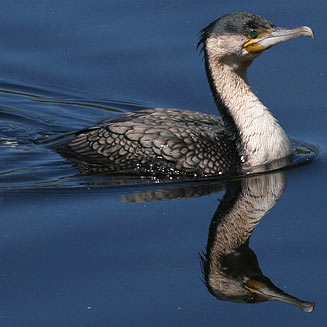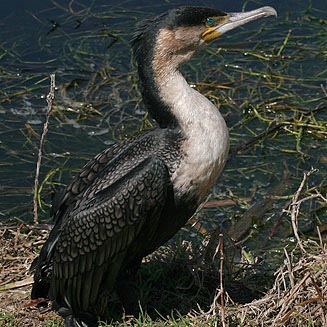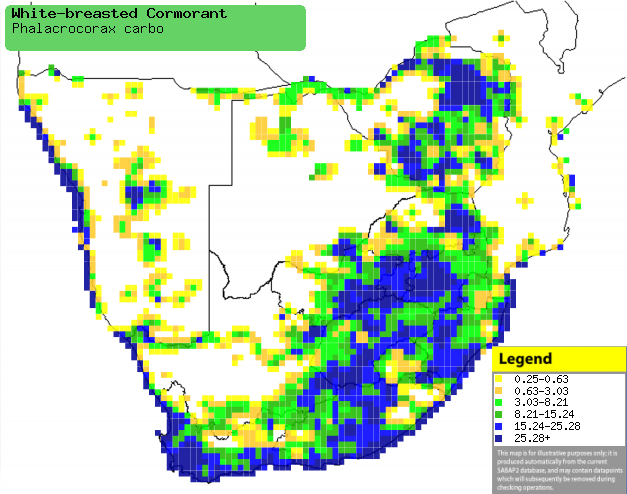Phalacrocorax carbo (White-breasted
cormorant)
[= Phalacrocorax carbo]
Witborsduiker [Afrikaans]; Ugwidi (generic
term for cormorants) [Xhosa]; iWonde [Zulu]; Nkororo (generic term for
cormorant) [Kwangali]; Timeletsane-botha [South Sotho]; Ngulukwani [Tsonga];
TimÍlÍtsane [Tswana]; aalscholver [Dutch]; Cormoran ŗ poitrine blanche
[French]; WeiŖbrustkormoran [German]; Corvo-marinho-de-faces-brancas
[Portuguese]
Life
> Eukaryotes >
Opisthokonta
> Metazoa (animals) >
Bilateria >
Deuterostomia > Chordata >
Craniata > Vertebrata (vertebrates) > Gnathostomata (jawed
vertebrates) > Teleostomi (teleost fish) > Osteichthyes (bony fish) > Class:
Sarcopterygii (lobe-finned
fish) > Stegocephalia (terrestrial
vertebrates) > Tetrapoda
(four-legged vertebrates) > Reptiliomorpha > Amniota >
Reptilia (reptiles) >
Romeriida > Diapsida > Archosauromorpha > Archosauria >
Dinosauria
(dinosaurs) > Saurischia > Theropoda (bipedal predatory dinosaurs) >
Coelurosauria > Maniraptora > Aves
(birds) > Order: Ciconiiformes
>
Family: Phalacrocoracidae
 |
 |
| White-breasted cormorant, Strandfontein Sewerage Works,
Western Cape, South Africa. [photo
Duncan Robertson
©] |
White-breasted cormorant, Strandfontein Sewerage
Works, Western Cape,
South Africa. [photo Duncan Robertson ©] |
Distribution and habitat
Occurs in patches of sub-Saharan Africa; in southern Africa it is common in Zimbabwe, much of South Africa (largely excluding
the arid Kalahari) and central and western Namibia, while more scarce in
northern and eastern Botswana and patches of Mozambique. It can occur in almost
any aquatic habitat, such as dams, streams, rivers, estuaries and the coast.
|
 |
|
Distribution of White-breasted cormorant in southern Africa,
based on statistical smoothing of the records from first SA Bird Atlas
Project (©
Animal Demography unit, University of
Cape Town; smoothing by Birgit Erni and Francesca Little). Colours range
from dark blue (most common) through to yellow (least common).
See here for the latest distribution
from the SABAP2. |
Predators and parasites
- Predators
- of adults
- Arctocephalus pusillus (Cape fur seals)
- of chicks and eggs
- Parasites
- Pasteurella multocida (Avian cholera)
Movements and migrations
Largely sedentary, although it may make
movements in response to changing water levels,
Food
It mainly eats fish, doing most of its foraging 10-200
metres from the shoreline (when foraging at sea), diving in stints of up to
about 82 seconds, although considerably less in freshwater. Its jaw is adapted
to handling bottom-dwelling slow-moving fish, but it may catch
faster fish that live closer to the surface. Smaller fish may be swallowed
underwater, but with larger fish it has to take them to shore: in one case a
bird died of suffocation after attempting to swallow a large Carp. The following food items have been recorded
in its diet:
- fish
- Aconthopagrus berda (Riverbream)
- Johnius dussumieri (Small kob)
- Rhabdosargus sarba (Natal stumpnose)
- Thryssa vitrirostris (Orangemouth glassnose)
- Atherina breviceps (Cape silverside)
- Cyprinus carpio (Carp)
- Oreochromis mossambicus (Mozambique tilapia)
- Myxus capensis (Freshwater mullet)
- Mugil cephalus (Flathead mullet)
- Trachurus trachurus (Horse mackerel)
- Cheilodactylus fasciatus (Redfinger)
- Pterogymnus laniarus (Panga)
- frogs
- Xenopus laevis (Common platanna)
- Afrana angolensis (Common river frog)'
- Phalacrocorax capensis (Cape
cormorant chicks)
- crabs
- molluscs
Breeding
- Usually a monogamous, colonial nester, typically living in colonies of
under 50 breeding pairs, although colonies of been recorded with over 700
breeding pairs. It is often joined by other
breeding birds, such as Reed
cormorants, African darters,
African spoonbills,
Cattle egrets and
other herons.
- The nest is built in roughly a week by the female, with material
collected by the male, consisting of a flat platform of sticks and twigs and
feathers, sometimes with seaweed and human debris. It is typically placed at a
largely predator-free site,
such as an island, cliff ledge, man-made guano pile, shipwreck, pylon, pan
wall or the shoreline of a dams or river.
- Egg-laying season is year-round, peaking from September-December in the
Western Cape and from January-July elsewhere.
- It lays 2-5, usually 3-4 eggs, which are incubated by both sexes for
about 27-28 days.
- The chicks are fed by both parents by regurgitation, leaving the nest at
about 28 days old. They fledge at about 49-56 days old, becoming fully
independent after another 40-50 days or so.
Threats
Not threatened, although colonies may be abandoned due to
human interference and predation by feral dogs.
References
-
Hockey PAR, Dean WRJ and Ryan PG 2005. Roberts
- Birds of southern Africa, VIIth ed. The Trustees of the John Voelcker
Bird Book Fund, Cape Town.
|
